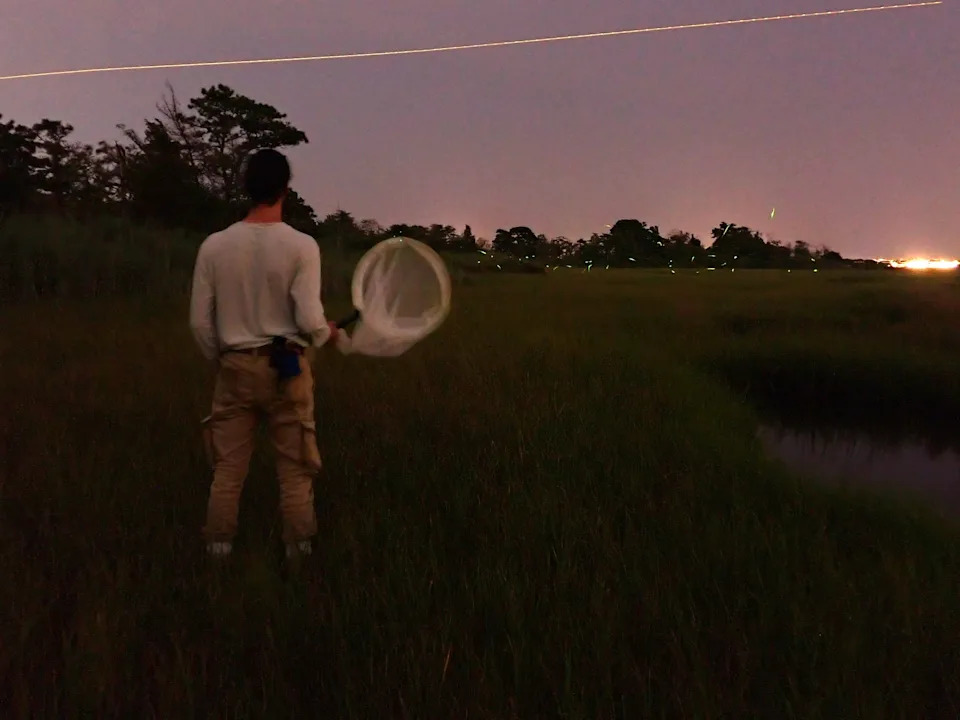Many people do not like bugs ... but who doesn't love fireflies?
They are naturally magical, illuminating a backyard like fireworks on a warm summer night. Here in New Jersey, and around much of the country, it would not feel like summer without them.
Fireflies, or lightning bugs as 87% of NorthJersey.com's readers call them, are found all over the world. They tend to like warm and fairly wet weather, typically appearing in May, June or July in the United States.
North America is home to approximately 150 species of fireflies, according to the New Jersey Department of Environmental Protection. About 30 of these species are known or thought to be found in New Jersey.
However, fireflies are not well studied or understood in the state, according to the NJDEP, which says, "Like so many of our other wildlife, fireflies are incredibly diverse with many having unique habitat and life history requirements."
Christopher M. Heckscher, firefly researcher and professor of environmental science and ecology at Delaware State University told NorthJersey.com last summer that this is not just an issue in New Jersey. Overall, according to Heckscher, we know so little about fireflies compared to some other species like dragonflies or butterflies.
"I think the reason we know so little about them in comparison to things like butterflies and dragonflies is because to study them you have to be willing to be outside late at night, sometimes in really remote areas," said Heckscher. "We found that fireflies are often associated with different types of wetlands, so not only do you have to be outside at night, but you also have to be in a wetland somewhere. That can be challenging."
Fireflies are facing numerous threats
Like many native species, fireflies are facing numerous threats from artificial light to overdevelopment, the draining of wetlands and the use of chemicals and pesticides.
As these threats persist, many have said that they are noticing less fireflies than they used to.
"Anecdotal reports describe fewer individuals being seen each year, and while long-term monitoring studies are scarce, some of the data we have are concerning," according to the Xerces Society for Invertebrate Conservation. In North America, for example, one in three firefly species may be at risk of extinction.
Are fireflies disappearing?
As fireflies remain a hot topic, many are asking the question, "Are fireflies disappearing?" According to Richard Joyce, conservation biologist for the Xerces Society, the answer is not so simple.
"People ask me how fireflies are doing, how their numbers are doing, and I usually have the follow-up question of, 'which species are you talking about?'" said Joyce. "New Jersey has around 30 ... species, and each of those species might have a different trend happening in terms of some species being stable, some might be declining a little bit, and some might be increasing due to recent weather conditions."
Joyce continued, "From everything that I've heard about fireflies on the East Coast, I think it has been a good couple of years."
For the last three and a half years, Joyce has focused his work with the Xerces Society on firefly conservation, helping to learn more about and protect at-risk species and supporting conservation efforts around the country. Although he is based in Massachusetts, Joyce has visited New Jersey multiple times to conduct firefly surveys.
Most recently, he spent time in the salt marshes of the Jersey Shore surveying two localized species: the keel-necked firefly and the salt marsh firefly.

The good news, he said, was that these two species were found in places they hadn't been found before, indicating that they are spread across the state's coastal salt marshes and that the population is bigger than originally thought. However, they are still facing multiple threats like sea level rise and water quality issues.
New Jersey's most common firefly is the common eastern firefly, also known as the big dipper firefly. Unlike some other species, according to Joyce, the big dipper firefly is very widespread and is adaptable to human impacted landscapes.
"There's no population monitoring happening at the species level for fireflies, and even if we were monitoring populations, I would say the big dipper firefly is not one that we would prioritize," said Joyce. "By all measures, it seems to be doing pretty well. It seems to be adapting to urbanization and agriculture and it's really like the little firefly that could."
He continued, "From a conservation standpoint, am I worried that the common eastern firefly is about to go extinct? No, not at all. Am I worried about some species of fireflies ... yes, I am."
How to help fireflies
If you are interested in helping fireflies, there are a few things that you can do right in your own backyard. Some actions you can take, according to Heckscher, Joyce and the Xerces Society, include:
Provide habitat for fireflies by setting aside part of your yard or garden where things can "get a little wild."
Avoid using chemicals and pesticides in your yard.
Turn off your outdoor lights at night, especially during the summer firefly season.
Leave things like leaf litter or damp wood in your yard if possible. Fireflies spend most of their lives in the soil and under leaf litter.
Get involved! Engage with local municipalities and governments as well as the people who manage your local parks to discuss ways that you can help fireflies in your area.
Contribute to the collective firefly knowledge by participating in a community science project, such as the Xerces Society's Firefly Atlas, which allows people to register and submit their firefly sightings.
Additionally, according to Joyce, there is a growing movement around the country to establish firefly sanctuaries as places where local species can be protected, studied and admired.
"There's some really inspiring stories from around the country of people who have gotten organized to uplift their local lightning bugs and really give them a safe place to live," said Joyce.
For more information, visit the Firefly Atlas guide at https://www.fireflyatlas.org/firefly-sanctuaries.
This article originally appeared on NorthJersey.com: Are fireflies disappearing? New Jersey's lightning bug population








Comments